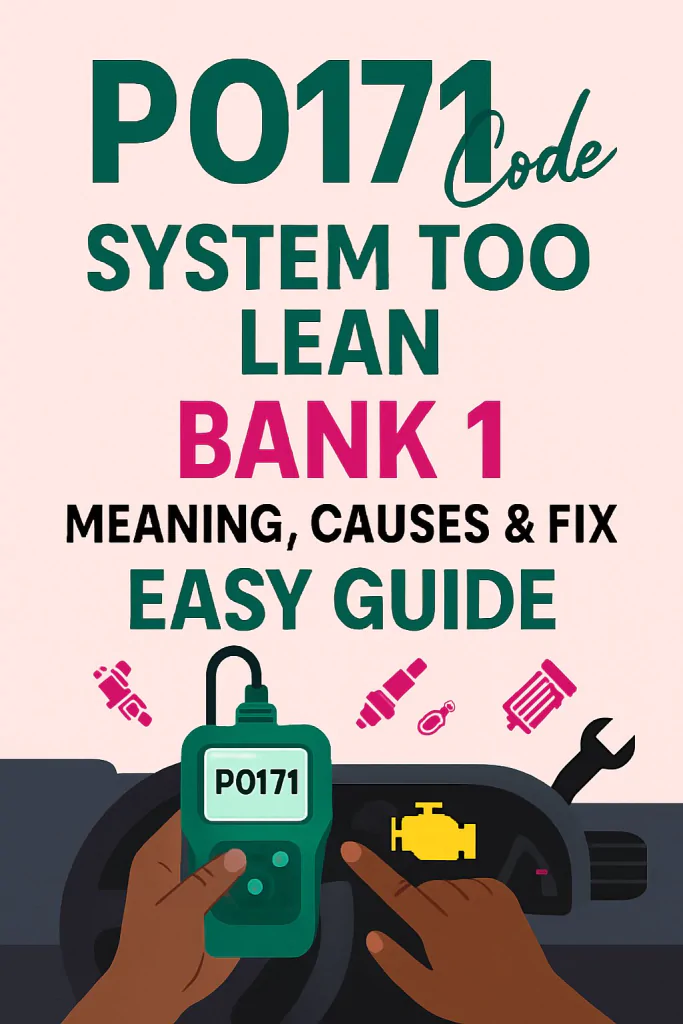P0171 Code: Causes, Symptoms, and 5 Easy Fixes for System Too Lean (Bank 1)

That Dreaded Check Engine Light Again
You’re cruising down the road, music on, coffee in hand, when suddenly that orange check engine light pops up. Ugh. Nothing kills the vibe faster. So, you grab your OBD-II scanner (because every car enthusiast has one, right?) and out comes the infamous P0171 Code: System Too Lean (Bank 1).
Now, if you’ve seen this code before, you already know it’s one of those “annoying but common” issues. If not, don’t sweat it—I’ve been there too. Back when my old Chevy Cruze first threw this code, I thought my engine was about to explode. Spoiler: it didn’t. But it did take some digging to understand what was happening.
Let’s break it down together—what it means, what’s causing it, the tell-tale signs, and most importantly, 5 easy fixes that could save you a ton of time (and $$$) at the mechanic.
What Does the P0171 Code Mean?
Simply put, the P0171 Code means your engine is running too lean. That’s mechanic-speak for: too much air, not enough fuel.
The “Bank 1” Part
- Bank 1 refers to the side of your engine where Cylinder #1 is located.
- If you’re driving a four-cylinder, there’s only one bank, so it’s always “Bank 1.”
- On a V6 or V8, you’ve got two banks, and “Bank 1” will depend on the engine layout.
Think of it like this: your engine is basically on a diet it didn’t sign up for. Not enough fuel means poor performance and potential long-term damage.
Symptoms of P0171: How Do You Know It’s Not Just in Your Head?
You might be wondering, “Okay, but how do I know for sure my car is running lean?” Great question. Here are the most common symptoms of a lean condition:
- Check Engine Light (duh, but worth stating).
- Rough idle – your car might feel shaky when stopped.
- Poor acceleration – that “laggy” feeling when you hit the gas.
- Engine misfires – sometimes subtle, sometimes dramatic.
- Increased fuel consumption – funny enough, a lean condition can make your car burn more fuel trying to compensate.
- Hard starting – especially when the engine is cold.
If you’ve got more than one of these symptoms along with the code, it’s a pretty solid bet you’re dealing with a lean condition.
Causes of P0171: Why Is My Engine Starving?
Here’s where it gets interesting. The P0171 can come from a bunch of different issues, but the common thread is that too much air sneaks in or too little fuel gets delivered.
Most Common Causes:
- Vacuum Leaks
- Cracked or loose vacuum hoses.
- Leaky intake manifold gasket.
- PCV valve stuck open.
- Dirty or Faulty Mass Air Flow (MAF) Sensor
- If the MAF can’t measure air properly, the engine won’t know how much fuel to add.
- Fuel Delivery Problems
- Weak fuel pump.
- Clogged fuel filter.
- Dirty or failing fuel injectors.
- Oxygen (O2) Sensor Issues
- A lazy O2 sensor can send false “lean” signals to the ECU.
- Exhaust Leaks Before the O2 Sensor
- Tiny cracks or leaks can trick the sensor into thinking there’s more oxygen than there really is.
5 Easy Fixes for P0171
Alright, now for the good stuff—what you can actually do about it. Here are five practical fixes you can try before running to the mechanic.
1. Check for Vacuum Leaks
- Pop the hood and inspect all vacuum hoses. Look for cracks, brittleness, or loose connections.
- Spray a little carb cleaner (carefully) around the intake area. If the idle changes, you found a leak.
👉 Fix: Replace the damaged hose or gasket. Most are cheap and DIY-friendly.
2. Clean the MAF Sensor
- The MAF is usually located between the air filter box and the throttle body.
- Dirt, dust, and oil can coat the sensor wires.
- Use MAF sensor cleaner (not brake cleaner!) to gently spray and clean it.
👉 Fix: Cleaning often restores proper readings. If it’s totally dead, replacement is still pretty affordable.
3. Inspect the Fuel System
- Check your fuel pressure using a fuel pressure gauge (many auto parts stores rent them out).
- If pressure is low, it could be the pump or filter.
- Dirty injectors? Add a quality fuel injector cleaner to your tank.
👉 Fix: Replace clogged filters, weak pumps, or have the injectors professionally cleaned.
4. Test and Replace the O2 Sensor
- The upstream O2 sensor (before the catalytic converter) is the one that monitors air/fuel mixture.
- If it’s slow to respond or stuck at certain readings, it’s likely bad.
👉 Fix: Replace it. O2 sensors are a little pricier, but still within most DIYer’s wheelhouse.
5. Check for Exhaust Leaks
- Listen for ticking sounds near the exhaust manifold.
- Look for black soot around gasket areas (a tell-tale leak sign).
👉 Fix: Replace gaskets or tighten bolts. Small leaks are cheap to fix early on.
Pro Tips: Don’t Skip These
- Reset the Code: After any repair, clear the code with your scanner and see if it comes back.
- Check Fuel Trims: If you have a scanner that shows fuel trims, aim for short-term trims within ±5%.
- Do One Fix at a Time: Don’t shotgun parts. Fix, test, repeat.
Is It Safe to Drive With a P0171 Code?
Short answer: Yes, but not for long.
A lean condition won’t usually strand you immediately, but if ignored, it can cause:
- Overheating.
- Damaged catalytic converter.
- Premature wear on pistons/valves.
So yeah, drive it home, but don’t daily it for weeks without fixing the issue.
DIY vs. Mechanic: Should You Fix It Yourself?
If you’ve got some tools and aren’t afraid of a little grease, DIY fixes for vacuum leaks, MAF cleaning, and fuel filters are 100% doable.
But if the problem ends up being deeper (fuel pump replacement, injector overhaul, major exhaust leak), you might want to let a pro handle it. IMO, it’s always worth trying the easy fixes first.
Wrapping It Up
So there you have it:
- P0171 Code = System Too Lean (Bank 1).
- Symptoms? Rough idle, poor acceleration, bad MPG.
- Causes? Anything that lets too much air in or not enough fuel.
- Fixes? Start with vacuum leaks, MAF cleaning, and fuel system checks.
Trust me, I know how stressful it feels to see that dreaded code pop up. But the good news is, most of the time, it’s not catastrophic. With a little patience (and maybe a can of MAF cleaner), you can knock out this issue and get back to enjoying the drive.
So next time your scanner flashes P0171, don’t panic. Instead, grab your tools, follow these steps, and you’ll be cruising worry-free in no time.
Happy wrenching, my friend! 🔧



![How To Clear Check Engine Light Without Code Reader [Clarified]](https://automotiveglory.com/wp-content/uploads/2024/05/how-to-clear-check-engine-light-without-code-reader-clarified_6098-768x529.jpg)


